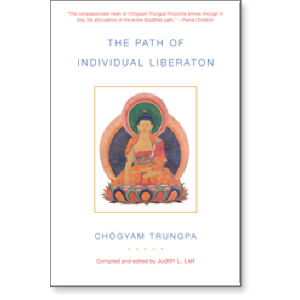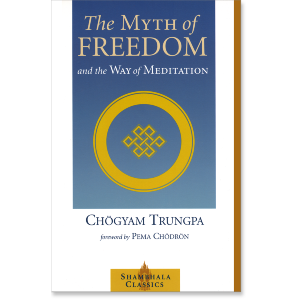The Noble Eightfold Path
from Chogyam Trungpa's The Path of Indivdual Liberation, volume One of the Profound Treasury of the Ocean of Dharma
There are eight categories of the path of meditation, which are collectively known as the noble eightfold path.* The eight limbs of the noble path are perfect view, perfect understanding, perfect speech, perfect end of karma, perfect livelihood, perfect effort, perfect recollection, and perfect meditation. At the level of the path of seeing, you began to see, and now you
are able to make something of it. Your whole being has been thoroughly trained physically, psychologically, and in terms of working with others.
Perfect View. The first limb of the noble path is yang-dak-pe tawa, or “perfect view.” Perfect view means that you are able to cut through the absorptions and fixed views of your previous experiences, which may have made you somewhat sleepy and theoretical. At the level of the path of seeing, you might have been able to gaze at the ultimate truth, but yang-dak-pe tawa enables you actually to see through.
“View” does not mean good view or bad view, but simply understanding things as they are. You are able to cut through and you are able to analyze and to theorize in the positive sense. This does not mean that you are scholastic or that you psychologize, but you are able to see the differences between the first, second, and third paths. You are able to see how things work geographically and chronologically. Because you can see through things at this point, you are becoming less dependent on your teacher, or elder. Your elder is wise and scholarly, brilliant and compassionate, but you don’t have to depend on him or her. You are able to see through by yourself; therefore, you are becoming somewhat independent.
Perfect Understanding. The second limb is yang-dak-pe tokpa, “perfect understanding,” or “perfect realization.” You have learned how to relax. Based on what you have experienced, there is no questioning and no doubt. You have understood, and you appreciate what you have understood; therefore, you learn how to relax and let yourself go.
Perfect Speech. The third limb is yang-dak-pe ngak, “perfect speech.” You have found a way of declaring yourself fully and thoroughly—how you are, why you are, what you are—without being arrogant, aggressive, or too humble. You have learned how to be moderate in presenting yourself. Ngak, “speech,” does not refer simply to how you speak, but also to how you reflect yourself to the world—your general demeanor, or decorum. You can become reasonable, decent, and enlightened.
Perfect End of Karma. The fourth limb is yang-dak-pe lekyi tha, which means, the “perfect end of karma.” You begin to understand how to prevent karmic cause and effects suddenly, precisely, and thoroughly. The end of karma means that you might return once or twice to the world because your immediate karmic situation has not yet been cut through; however, your previous karma has been cut through already by means of perfect view, perfect understanding, and perfect speech. Your habitual patterns and your whole behavior begin to be more accurate, more enlightened. By behaving naturally, you are able to cut through karma and karmic consequences.
In cutting through karma, you are constantly dealing with ignorance, the first nidana. Since volitional action is driven by ignorance, if you are able to cut through that ignorance, you stop the course of volitional action. You can do so, because at the level of the path of meditation, your style of relating with the dharma becomes very natural and instinctive. In contrast, the style of volitional action is that you are always looking forward to the next carrot. You see the carrot as somewhat distant from you, and you work yourself up to run from here to there, from yourself to the carrot. In doing so, you crank up more karma; and when you get there, you end up with the next karmic cause. So you end up with a lot more karma—and you have created the carrot, as well! We never say that in the samsaric world, but in the enlightened world we can say it.
In cutting karma, disgust and renunciation are regarded as important. Although it is a neat, ugly trick for you to put the carrot in front of yourself, you know you shouldn’t be doing that. By renouncing that, you are able to cut the second nidana, which is formation, or impulsive accumulation. At this point, you are becoming so accomplished in this that even if you plant a karmic promise in other people, you are able to cut through their karmic cause and effect as well.
Perfect Livelihood. Number five is yang-dak-pe tsowa, which means “perfect livelihood.” Because you are able to handle karmic cause and effect, you can also relate with your own life and livelihood. You do not have to depend on others. You have enough skill to be able to handle your livelihood thoroughly and fully.
Perfect Effort. The sixth limb is yang-dak-pe tsölwa, which means “perfect effort.” This has the sense of not holding back, but exerting yourself. You have tremendous energy. You cultivate genuine energy in both working with yourself and working with others. As you go from path to path, you develop more and more effort, more and more industry. You begin to become a decent person, no longer a nuisance.
Perfect Recollection. The seventh limb is yang-dak-pe trenpa, “perfect recollection.” As before, trenpa refers to mindfulness, or one-pointed mind, and to the recollection of your previous experiences.
Perfect Meditation. The eighth and last limb of the noble path is yangdak-pe tingdzin, or “perfect meditation.” In this context, tingdzin means that you are able to enter into certain samadhis. You begin to look ahead toward the notion of enlightenment. At this point, you might be able to completely cut through twofold ego fixation (ego of self and ego of dharmas).
* Trungpa Rinpoche also discusses the eightfold path in The Myth of Freedom and the Way of Meditation (Boston: Shambhala, 1988).



